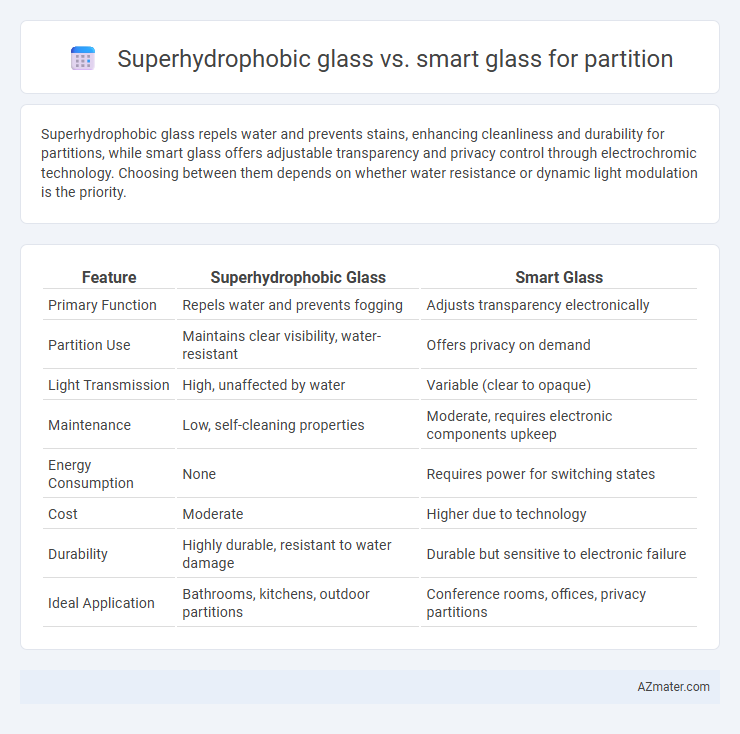Superhydrophobic glass repels water and prevents stains, enhancing cleanliness and durability for partitions, while smart glass offers adjustable transparency and privacy control through electrochromic technology. Choosing between them depends on whether water resistance or dynamic light modulation is the priority.
Table of Comparison
| Feature | Superhydrophobic Glass | Smart Glass |
|---|---|---|
| Primary Function | Repels water and prevents fogging | Adjusts transparency electronically |
| Partition Use | Maintains clear visibility, water-resistant | Offers privacy on demand |
| Light Transmission | High, unaffected by water | Variable (clear to opaque) |
| Maintenance | Low, self-cleaning properties | Moderate, requires electronic components upkeep |
| Energy Consumption | None | Requires power for switching states |
| Cost | Moderate | Higher due to technology |
| Durability | Highly durable, resistant to water damage | Durable but sensitive to electronic failure |
| Ideal Application | Bathrooms, kitchens, outdoor partitions | Conference rooms, offices, privacy partitions |
Introduction to Glass Technologies for Partitions
Superhydrophobic glass features a nano-textured surface that repels water and dirt, enhancing cleanliness and maintenance efficiency in partitions. Smart glass, also known as switchable glass, utilizes liquid crystal or electrochromic technology to adjust transparency and control light transmission for privacy and energy savings. Both technologies offer advanced functional benefits, with superhydrophobic glass emphasizing durability and low maintenance, while smart glass prioritizes dynamic control over light and privacy in partition applications.
What is Superhydrophobic Glass?
Superhydrophobic glass is a type of surface-treated glass engineered to repel water, causing droplets to bead up and roll off easily, preventing moisture accumulation and staining. This water-resistant property enhances durability and cleanliness, making it ideal for partitions in humid or high-traffic environments. Unlike smart glass, which adjusts transparency for privacy and light control, superhydrophobic glass primarily focuses on maintaining a clear, dry surface without requiring electrical input.
What is Smart Glass?
Smart glass is an advanced material that can change its light transmission properties in response to environmental stimuli like electric voltage, heat, or light, making it ideal for partitions requiring adjustable privacy and light control. It offers dynamic opacity control, energy efficiency, and aesthetic flexibility, differentiating it from static materials like superhydrophobic glass, which primarily provides water repellency and self-cleaning features. Smart glass partitions integrate seamlessly into modern architectural designs, enhancing comfort and functionality through their adaptive transparency.
Core Features: Superhydrophobic Glass
Superhydrophobic glass features a microscopic textured surface that repels water and resists staining, ensuring clarity and durability in partition applications. Its core property of extreme water repellency creates a self-cleaning effect, reducing maintenance and preventing mold or mildew buildup. Unlike smart glass, which controls light transmission, superhydrophobic glass prioritizes surface protection and hydration resistance for long-lasting transparency.
Core Features: Smart Glass
Smart glass partitions offer dynamic light control through electrochromic technology, enabling instant transition between transparent and opaque states for privacy and energy efficiency. These partitions adapt to environmental conditions, reducing glare and UV exposure while maintaining natural daylight. Integration with building automation systems enhances functionality, making smart glass an ideal solution for modern, flexible spaces.
Durability and Maintenance
Superhydrophobic glass offers exceptional durability with its self-cleaning properties, reducing the need for frequent maintenance by repelling water, dirt, and grime. Smart glass, while durable, requires more careful handling due to its embedded electronic components that can be sensitive to scratches and moisture. Maintenance for smart glass involves routine checks of its electrical system and coatings, whereas superhydrophobic glass primarily needs occasional surface cleaning to maintain its hydrophobic efficiency.
Privacy and Light Control Capabilities
Superhydrophobic glass offers excellent water repellency with moderate privacy by creating a translucent barrier that diffuses light, reducing glare while maintaining some natural illumination. Smart glass provides superior light control and privacy by dynamically adjusting transparency or opacity through electrical stimuli, allowing instant switching from clear to frosted states. For partitions, smart glass is preferred where adjustable privacy and precise light modulation are critical, while superhydrophobic glass suits environments needing water resistance and soft privacy with less control over light transmission.
Energy Efficiency Comparison
Superhydrophobic glass offers superior energy efficiency by reducing heat transfer and minimizing water retention, which helps maintain consistent indoor temperatures and decreases cooling costs. Smart glass enhances energy savings through dynamic tinting that adapts to sunlight intensity, optimizing natural light and reducing the need for artificial lighting and HVAC use. Comparing the two, smart glass provides more active control over solar heat gain, while superhydrophobic glass contributes passive energy benefits through its water-repellent and insulating properties.
Cost and Installation Factors
Superhydrophobic glass offers high water repellency and self-cleaning properties but tends to be more expensive due to advanced coatings and specialized manufacturing processes. Smart glass, known for its switchable transparency, usually involves higher installation complexity requiring electrical wiring and control systems, increasing labor costs. While superhydrophobic glass installation aligns with standard glazing methods, smart glass demands skilled technicians and longer installation times, impacting overall project budgets.
Which Glass Type is Best for Your Partition Needs?
Superhydrophobic glass offers superior water and stain resistance, making it ideal for partitions in environments prone to moisture and dirt, such as bathrooms and kitchens. Smart glass provides dynamic light control and privacy through electrochromic technology, perfect for office spaces or areas needing adjustable opacity. Choosing the best glass type depends on whether you prioritize maintenance ease and cleanliness with superhydrophobic properties or customizable privacy and energy efficiency with smart glass.

Infographic: Superhydrophobic glass vs Smart glass for Partition
 azmater.com
azmater.com